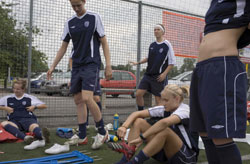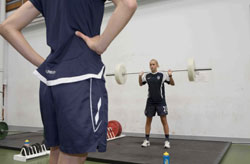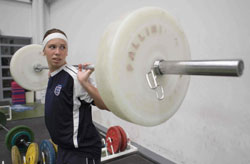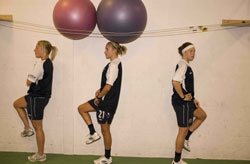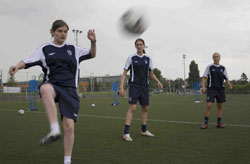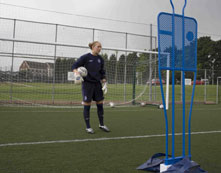The future's feminine: the development of women's football
(chinadaily.com.cn/FIFA)
Updated: 2007-12-24 16:45
Updated: 2007-12-24 16:45
Football is the fastest-growing women’s sport in the world. Yes, that’s women’s sport!
Participation has more than doubled since the year 2000 and there are now an estimated 26 million women playing football worldwide.
But one country where the rise in the popularity of the women’s game has been really exceptional is perhaps a surprise. It’s England.
You would expect that the nation which created the modern game of Association Football - the country which has the wealthiest and best-supported league in the world, and whose Premiership clubs like Manchester United and Liverpool are global brand names - would be supportive of the women’s game. But until very recently this was far from the case and, indeed, women were even banned from playing on league grounds until the 1960s!
It was not until 1993 that the English FA took the women’s game under its wing and started to invest in it seriously in terms of money and infrastructure. Fifteen years ago there were some 10,000 women in England playing for amateur clubs – now there are 147,000. And the Active People Survey completed in 2006 highlighted that 250,000 women and 1.1 million girls were playing some form of football - a truly astonishing rise in interest.
But Mary Harvey, Head of Development for FIFA, thinks that perhaps the rise not so extraordinary given the high profile and popularity of the men’s game. “You take a girl growing up in England - or in Brazil or Argentina - where football is their national sport. It’s
not the national men’s sport. It’s the national sport of the country and, if you look at the audiences that attended the 2006 FIFA World Cup and also watched it on television, there was a big, big percentage of females. So it’s not really a surprise that they love it. But what is now happening is that more and more opportunities are being given to girls and structures are being put in place to enable them to play. The desire’s there to participate in the sport of football and that’s what changing!” Until fairly recently in England (one of four countries that make up the United Kingdom, which also includes Scotland, Wales and Northern Ireland), football was not considered a suitable game for girls. They were expected to play netball or hockey but there are now plenty of opportunities for any young woman keen on the game to progress.
Kelly Simmons Head of Football Development for the FA explains how the infrastructure works: “Every one of the 42 English counties has a development officer who works with schools and local clubs to set up girls’ teams and help girls move on through schools into football clubs and leagues to get regular competition. There are local centres of excellence for talented girls with weekly coaching and games programmes. And there is a national academy at Loughborough in the Midlands where the England youth teams train and then, if they are good enough, players can progress right through to the senior team.
Lois Fidler is the Centre Manager at the National Player Development Centre in Loughborough, which was opened in 2001. Since then, between 12 and 22 girls are selected for the specialist training camps every year: “We consult with the national team coaches and players who have demonstrated potential within the international youth squads are invited to train at Loughborough,” she says.
“We work with a four-corner model to develop not only their physical strength and ability, their technical and tactical competence, their psychology so that they can cope with the pressure of tournament football and the social aspect of being able to interact with their team-mates. We want to develop the whole player in a holistic approach.”
As a result of this hard work, England has qualified FIFA Women’s World Cup for the first time since 1995. “I think we’ve got a great chance,” says Kelly Simmons. “Because we haven’t been in the last couple of World Cups, not a great deal is known about the England team. Yet we’ve got a lot of good young players coming through. I think it’s fantastic that we’re there.
“It’s a great opportunity to raise the profile of the women’s game in this country, also raise the profile of some great role models that we’ve got in the England team, and keep growing the game.”
Perhaps she is being optimistic because, realistically, England will do well get through in a tough group featuring, Japan, Argentina and Germany, the current World Cup-holders.
The team arrived early in host-country China to acclimatise and played a warm-up match in Macao against the Chinese women in a searing 30º heat and 90% humidity. “Unfortunately we lost 1-0,” says goalkeeper, Siobhan Chamberlain, but it was a good team performance and we felt we played well enough to win. We just needed to take our chances. It was a good test for us as we had never played a match in those conditions before, and that is what we will experience in the World Cup games.”
England was the birthplace of modern football but it was Ancient China 5,000 years ago that saw the first formal type of football game where participants kicked a ball stuffed with feathers. And China, who were also hosts for the first FIFA Women’s World Cup in 1991, would dearly love to win on their home territory.
Whilst the England women are steadily improving their performance, the Chinese are concerned that they have been going backwards since the turn of the century. In the 1990s, women’s football enjoyed a steady growth. In 1991 China were fifth in the Women’s World Cup; in 1995 they were fourth; in 1999 runners-up; and in 1996 in the Atlanta Olympics, China won the silver medal. And they were dominant in Asia, too, during that period.
But, since then, China has failed to make an impact at either the FIFA Women’s World Cup or the Olympics.
Chinese officials put the decline down to the fact that the European teams have been getting stronger and a lack of supply of players to the Chinese national team. They also felt that they were beginning to lag behind in terms of training and strategy.
China now have a new development plan. This involves making the national team a priority and improving the league competition set-up and training mechanisms for players at all level and also for coaches.
And, in terms of coaches, China has taken the bold step of engaging a Swede Marika Domanski-Lyfors who coached the Swedish team to the 2003 FIFA Women’s World Cup Final where they lost to Germany.
One of China’s star players, Han Duan, is full of praise for the new coach and says: “Her arrival has brought us more encouragement and confidence and we are more focussed and engaged during training. And we have more passion for the game and our own capacity to develop our individual skills.”
Han, a 23-year-old striker, owes her first interest in football to her father Han Jianli (family names are stated first in China and followed by the given name), who was himself an amateur footballer. He discovered that his daughter had a natural ability for the game when she was just six years old: “I could see from every movement of her body that she had talent. I trained her to keep up the ball, dribble it and kick it at a designated place such as a tree and she did it very well and obviously enjoyed it very much.”
Han started to play more seriously when she was still only eight when she enrolled in a school that specialised in football in her home town of Da Lian, progressing to the Chinese junior team and later on to the national team itself.
“In China there are a relatively small number of female teenage footballers, she says, “But I noticed when I was visiting the USA that they were very many girls and women playing the game (40% the USA’s 20 million players are female) so I think the Chinese junior footballer training scheme needs to be more comprehensive and that parents should encourage their daughters to play.”
Whilst the men’s game is popular in China, the Chinese national men’s team has never been very successful and currently lies a lowly 85th in the Coca-Cola FIFA Men’s World Rankings. The England men’s team lies 12th, coincidentally exactly the same position as the England women in the Women’s World ranking. China’s women are one position above them at 11th.
And China probably have as difficult a job as England in getting through their first round. They play Denmark and Brazil who are above them in the rankings at 6th and 8th respectively, and New Zealand, the only opponents ranked below them .
Coach Domaski-Lyfors has set a target to reach the semi-finals but the nation’s eyes are on the FIFA Women’s World Cup itself!
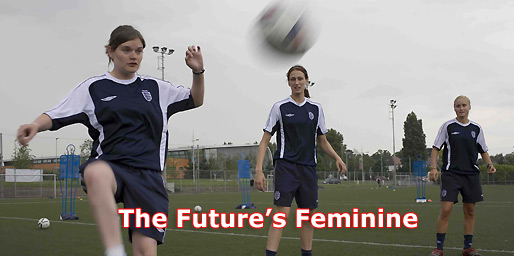
|
|
|
||
|
||
|
|
|
|

